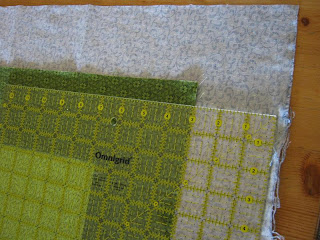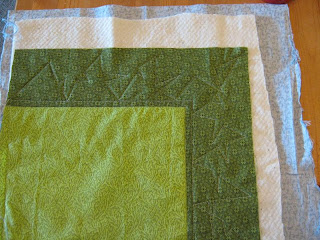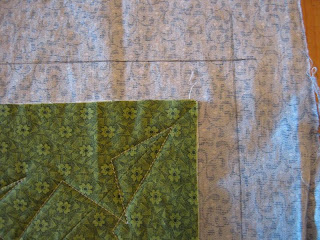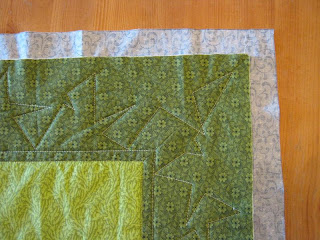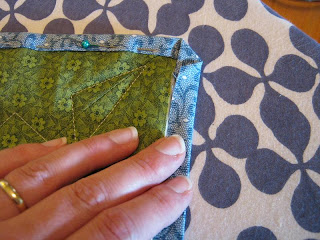
When I have the time and I plan ahead, I have the luxury of basting quilts on the great, big, perfect-height cutting table at
the workroom.
However, there are times when I want a top basted
right now, and the tops are often too big to fit entirely on the surface of my dining room table. No matter! I baste it anyway and here's how I do it.
I put the extra leaf in my table; it's an old IKEA table that's been used and abused over the years. Though we still love it, it is already a bit scarred on the surface so I have no qualms about sticking in my safety pins and adding to the rich assortment of scratches that are already there. I'm adding "patina." See how that works?

So, I press my backing on a tabletop ironing board (handy!) and then I tape the backing so the length of my quilt will fit on my table, but one edge hangs over the side of the table. I tape the three sides of the backing, layer and carefully smooth out my batting, then layer on my quilt top. (I'm working with an Amish-style Bars quilt top that I just made. It will be quilted in red and blue, with a blue binding! Anyway...) I smooth out the top and proceed with the safety pins.



When my pins are all in, I thread-baste the one continuous long edge I have available to me.


Then, I untape the backing and simply slide the whole thing over so the extra un-basted part is now resting on my tabletop, and the now-basted part is hanging over the
other side of the table.


I peel back the top and batting and smooth down and tape the backing on three sides.

Then I carefully smooth down the batting, and then unfold the top over it and smooth it down, too. (Did I mention the "smoothing" part?)


Now I finish up my pin-basting and thread-baste the other full side of the quilt sandwich.

Almost ready! Just untape the backing from the table and swing the whole thing around so you can thread-baste each shorter side in turn. Trim your batting and backing down a bit if you like.

(I have used this technique for even larger quilts, too. I do the middle third of the quilt, then do the outer thirds one at a time. Make sure that your quilt sandwich is supported on a couple of chairs when you do the outer thirds.)
You now have a fully-basted,
smooth quilt sandwich that is ready for quilting!
And you did it without killing your back by doing it on the floor (ouch!) and you didn't waste
valuable sewing time waiting for the perfect basting table to become available.
See? You can do it! Now get quilting!
















